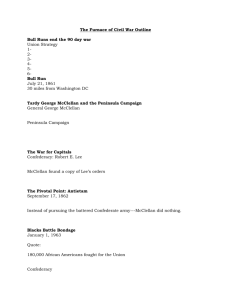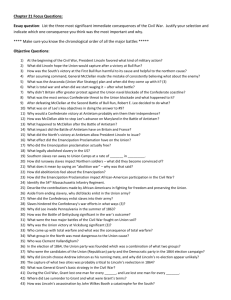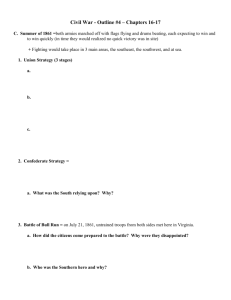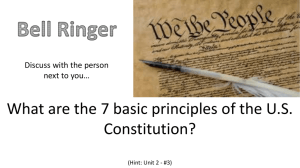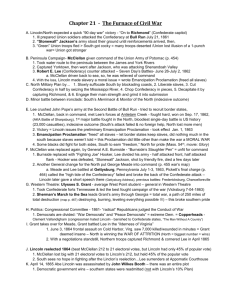Vocabulary
advertisement
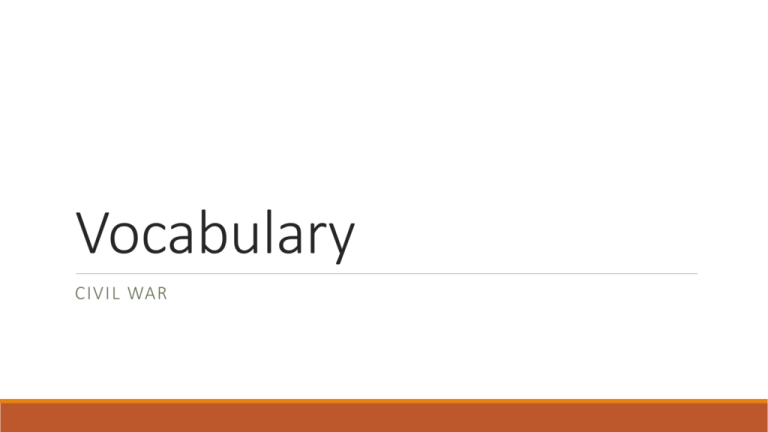
Vocabulary CIVIL WAR Fort Sumter Union fort in the harbor of Charleston, South Carolina Confederacy Nation formed by Southern states Robert E. Lee Confederate general, commander of the Army of Northern Virginia Border States Slave states that bordered states in which slavery was illegal Anaconda Plan Union strategy to defeat the Confederacy First Battle of Bull Run First major battle of the Civil War Thomas J. Jackson Confederate general at Bull Run War Erupts: One American’s Story 1) Emma Holmes got caught up in the passions of the beginning of war. 2) Emma wrote about the attack on Fort Sumter in her diary after watching it for four hours First Shots at Fort Sumter 1) Lincoln had to decide on what to do with forts remaining in Southern territory 2) Lincoln decided to supply Fort Sumter, but the South attacked before the supplies could arrive 3) The Confederates fired on Fort Sumter for a total of 34 hours until it surrendered. Lincoln Calls Out the Militia 1) Lincoln asked Union states to provide 75,000 militiamen 2) States near the north were outraged and decided to join the South instead of helping Lincoln 3) Volunteers rushed to enlist 4) Robert E. Lee left the United States Army to return home to Virginia where he would lead the Confederacy Choosing Sides 1) Border states became a contested area because both sides knew they could tip the scales of war 2) Keeping Maryland in the Union was important for the North because it held the capital 3) West Virginia separated from Virginia because it did not want to be part of the South. Admitted to the Union in 1863 Strengths and Weaknesses 1) The Union had huge advantages in manpower and resources 2) The Unions greatest asset was Lincoln and his leadership 3) The confederacy had superior generals and a soldier’s will to fight The Confederate Strategy 1) The Confederacy started by taking a defensive position. 2) They tried to call on European powers to help them, but France and Britain wanted nothing to do with the American Civil War. 3) As the war heated up, the South soon took the offensive to try for big victories to end the war. The Union Strategy 1) The North wanted to slowly suffocate the South’s economy. Anaconda Plan. 2) The plan called for blockades and to control the Mississippi River. 3) The drawback was that it would take time to work, and many leaders did not want to wait. Battle of Bull Run 1) Lincoln ordered an invasion of Virginia to try and take Richmond, but Northern troops ran into Southern troops stationed at Manassas first. 2) The first major battle of the Civil War took place near a creek named Bull Run just north of Manassas 3) This is where Thomas Jackson got his nickname “Stonewall” because he was fearless in battle and rallied his troops 4) The Confederates gained reinforcements and gave out a blood curdling scream called the “rebel yell”. This drove away the Northern troops and the South got their first victory. The Monitor Union ironclad ship The Merrimack Confederate ironclad ship, later renamed the Virginia Life in the Army: One American’s Story 1) Peter Vrendenburgh volunteered for the infantry in the North 2) He wrote home urging his parents not to let his brother enlist due to what he saw Those Who Fought 1) The majority of soldiers were between the ages of 18-30, but some as young as 11 joined and some as old as 83 joined. 2) Farmers made up the majority of soldiers that fought 3) Immigrants also served and made up a large number of troops 4) African Americans could not join at first, but the North later allowed them to fight. Many soldiers sought adventure, money, and joined due to loyalty. Turning Civilians into soldiers 1) Soldiers lived in tents 2) Training camps had strict schedules and soldiers performed various duties such as cutting wood, guard duty, and cleaning. 3) The North wore blue uniforms and the South wore gray or yellowish-brown 4) Uniforms in the North were made poorly and the South struggled to supply enough for their troops Hardships of Army Life 1) Life in the camps was sometimes extremely unsanitary 2) Soldiers were filthy and went weeks without bathing 3) Poor hygiene resulted in widespread sickness and doctors did not know about diseases when amputating Changes in Military Technology 1) Battle tactics changed and casualties soared 2) Rifles that used minie balls contributed to high casualty rates 3) Ironclads were a vast improvement over wooden ships Enlist To join the armed forces George McClellan Commander of Union army in the east Ulysses S. Grant Union general who won battles in the west Battle of Shiloh Bloody battle in Tennessee won by Grant William Tecumseh Sherman Union general at Battle of Shiloh David Farragut Union naval commander who captured New Orleans Seven Days’ Battles Confederate victory in Virginia, during which Lee stopped Union campaign against Richmond Battle of Antietam Battle in Maryland that ended Lee’s first invasion of the North No End In Sight 1) Lincoln soon gave McClellan control of the army and he restored confidence and organized them 2) Lincoln urged McClellan to attack Richmond, but McClellan kept training Union Victories in the West 1) While McClellan was stalling in the East, Ulysses S. Grant was winning in the West 2) Grant captured two river forts that allowed him to go deeper into the South The Battle of Shiloh 1) Grant chased the fleeing Southern troops near southern Tennessee but then stopped to gain reinforcements. The South rallied and attacked before he could gain reinforcements. 2) This battle was the fiercest the war had yet seen and by the end of the day each side thought they would win by dawn 3) Grant used Union boats to ferry fresh troops to him by using the river he had captured. He attacked at dawn with his fresh troops and forced the South to retreat. 4) Union casualties numbered 13,000 and Confederate casualties numbered 11,000 The Fall of New Orleans 1) David Farragut captured New Orleans, the largest city in the South. 2) This dealt a heavy blow to the South and the Union almost succeeded in its plan to split the South in two. Lee Claims Victories in the East 1) McClellan finally made his move to try and capture Richmond 2) Lee spied on McClellan’s army and decided to attack first taking heavy loses but driving McClellan back (Seven Days’ Battles) Lee Invades the North 1) After many victories, Lee decides to invade the North 2) Lee hoped to a victory in the North might force Lincoln to talk peace 3) Lee tried to also show France and Britain that they could win the war and hopefully get them to join Bloody Antietam 1) While Lee was making plans to invade, a Confederate officer accidentally left a copy of the plans behind and a Union soldier found them 2) McClellan had a chance to stop Lee, but he did not act fast enough. McClellan was very slow and methodical. 3) McClellan finally attacked Lee near Antietam Creek in Maryland. The Battle of Antietam was the bloodiest day in all of American history with nearly 25,000 Americans dead or wounded. Lee Withdrew and McClellan had a chance to finish him off but he stalled.
